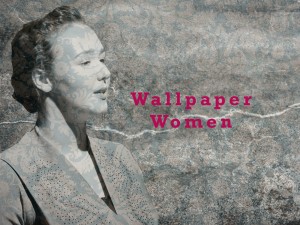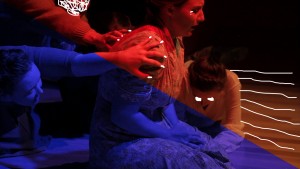Wallpaper Women 2016, k-film installation, Mimi Hamra, Bridget Ince
Wallpaper Women focuses on drawing attention to the lack of representation of women in ANZAC commemorations, by highlighting the roles they carried out during the First World War. The women of this time period took on the role of mother, lover, carer, nurse and war workers. These responsibilities often remain unrecognised and undervalued by society. The women of war played an important role and although not on the front line of battle, they still experienced significant trauma. Inspired by feminist artists we repurposed the Carrying Home video footage by adding music and text to each video granule. The structure of our work focused on the emotions that women experienced, using multiple relations between video granules to demonstrate the many difficulties women faced.
Drawing Attention 2016, k-film installation, Maria Ocaranza Bortoni, Eloise Large, Louis Powlett
Drawing Attention focuses on bringing to the surface the subconscious trauma that the characters are portraying in the Carrying Home theatre production experienced. The work intends to provoke the associated mental suffering that the ANZAC men and women endured during the first world war. Using a process of hand-drawn animation over live action footage, our K-film provides visual cues directing the viewer towards the trauma within each scene. Utilising the interactive functionality and structure of the Korsakow software our intent was to display the chaos that is produced by these traumatic experiences, therefore the relations created between the clips are designed to show disparate flashes of footage relating back to the way in which trauma is experienced.
The Fluidity of Home, 2016, k-film installation, Siobhan Bird, Corey Lisle, Matthew Manning
The Fluidity of Home seeks to highlight how home is represented in the Carrying Home play, and what home meant more broadly to the ANZACs during World War 1. We wanted to communicate how the idea of home can change through the experience of war. Using the database attributes of interactive media we aimed to create a type of collection, a “cabinet of curiosities”. Our collection of video granules consists of 1920’s household objects that we collected from the Melbourne Museum, which were post-produced to look like archive material. We also added contemporary objects such as a lego house, teacups, and an Australian Rules football, which we shot in slow motion, in distressed situations to communicate the fragility of home during wartime. The idea was to use links in this interactive media work like edits in a film, to place household objects against moments from the play, and engage the user in the juxtapositions they create.
Love in Times of War 2016, k-film installation, Arisara Aueviboonphol, Rachel Melisa, Ceyda Resuloglu
Love in Times of War seeks to bring attention to the theme of Love in the Carrying Home play. We wanted to explore how the notion of love is altered and changed by war. With each video granule we used the cut up technique, taking inspiration from William S Burroughs’ works. Using this technique, we deconstructed the idea of love and war to create narratives of those affected by war. The cut up technique follows no rules so we used this technique in carrying home to edit segments from the play and combine them to tell the story in a different way. To create the letters, we used the script written by Dan Nixon and Ben Byrne. The letters were then used as voice overs to accompany the footage. Using the interactive software Korsakow, we aimed to create letters that defy time and war to show the love between the recipients and writers of the letters. Through Love In Times of War we wanted to shed light to the unchanging nature of love and how words, as the only form of communication at that time, were used to express such love.
Drip Drop 2016, k-film installation, Yiwen Jiang, Chen-Lin Huang, Jack Worthington
Drip Drop uses Korsakow to reappropriate the Carrying Home play into a video game. Using the script from the play, Drip Drop follows observers as additional characters through the events of the play. Our aim with the k-film is to make an accessible lens for younger generations to understand the battle for Gallipoli, as well as Australia’s contributions to World War one more broadly.
Memories In Action 2016, k-film installation, Anna Miers, Margaret Tanjutco
Memories In Action is a series of short clips exploring the psychological impacts of war towards young people on the front. By fusing archival and production footage, we created a well-rounded outlook on the ANZAC experience.

